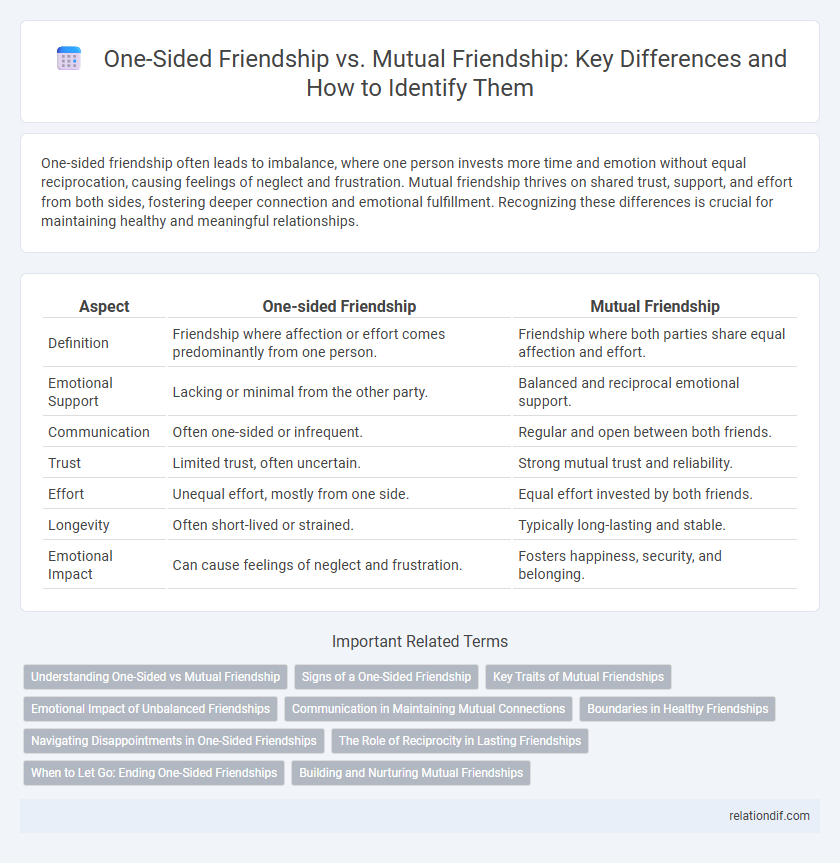One-sided friendship often leads to imbalance, where one person invests more time and emotion without equal reciprocation, causing feelings of neglect and frustration. Mutual friendship thrives on shared trust, support, and effort from both sides, fostering deeper connection and emotional fulfillment. Recognizing these differences is crucial for maintaining healthy and meaningful relationships.
Table of Comparison
| Aspect | One-sided Friendship | Mutual Friendship |
|---|---|---|
| Definition | Friendship where affection or effort comes predominantly from one person. | Friendship where both parties share equal affection and effort. |
| Emotional Support | Lacking or minimal from the other party. | Balanced and reciprocal emotional support. |
| Communication | Often one-sided or infrequent. | Regular and open between both friends. |
| Trust | Limited trust, often uncertain. | Strong mutual trust and reliability. |
| Effort | Unequal effort, mostly from one side. | Equal effort invested by both friends. |
| Longevity | Often short-lived or strained. | Typically long-lasting and stable. |
| Emotional Impact | Can cause feelings of neglect and frustration. | Fosters happiness, security, and belonging. |
Understanding One-Sided vs Mutual Friendship
One-sided friendship often involves unbalanced emotional investment where one person consistently gives support while the other remains distant or disengaged, leading to feelings of neglect and frustration. Mutual friendship, by contrast, is characterized by reciprocal trust, open communication, and shared experiences that foster equality and deep emotional connection. Understanding these dynamics is crucial for recognizing genuine bonds and addressing potential imbalances in social relationships.
Signs of a One-Sided Friendship
Signs of a one-sided friendship include consistently being the only person initiating contact, making plans, or investing emotional energy without equal reciprocation. In such relationships, one friend may frequently cancel or ignore commitments, leaving the other feeling unsupported and undervalued. Mutual friendships, by contrast, demonstrate balanced effort, active listening, and shared enthusiasm in maintaining the connection.
Key Traits of Mutual Friendships
Mutual friendships are characterized by balanced support, reciprocal trust, and open communication, fostering a deep sense of connection and respect between individuals. Both friends actively contribute to the relationship, sharing experiences and emotions equally, which strengthens their bond over time. These key traits enable mutual friendships to provide emotional stability, loyalty, and genuine companionship, distinguishing them from one-sided friendships where effort and care are unilaterally distributed.
Emotional Impact of Unbalanced Friendships
Unbalanced friendships often lead to feelings of neglect, frustration, and emotional exhaustion for the individual investing more effort, creating a persistent sense of loneliness despite the connection. Mutual friendships foster emotional support, trust, and reciprocity, which significantly enhance psychological well-being and resilience. The emotional impact of one-sided friendships can increase stress and reduce self-esteem, highlighting the importance of balanced, reciprocal relationships for mental health.
Communication in Maintaining Mutual Connections
Effective communication is crucial in maintaining mutual friendships, allowing both parties to express feelings, share experiences, and resolve misunderstandings. One-sided friendships often suffer from imbalanced communication, where only one individual invests effort, leading to frustration and emotional disconnect. Regular, open dialogue strengthens trust and ensures that both friends feel valued and heard, fostering a healthy and enduring connection.
Boundaries in Healthy Friendships
Healthy friendships establish clear boundaries that respect each person's needs and emotions, preventing feelings of resentment or imbalance. One-sided friendships often lack these boundaries, leading to emotional exhaustion and misunderstandings. Mutual friendships thrive when both individuals communicate openly and honor personal limits, fostering trust and long-term connection.
Navigating Disappointments in One-Sided Friendships
One-sided friendships often lead to feelings of disappointment and emotional exhaustion when efforts and affections are not reciprocated. Recognizing the imbalance allows individuals to set healthy boundaries and reassess the value of such relationships. Prioritizing mutual friendships fosters emotional support, trust, and genuine connection essential for long-term well-being.
The Role of Reciprocity in Lasting Friendships
Reciprocity plays a crucial role in establishing lasting friendships by ensuring that both parties consistently invest emotional support, trust, and effort. One-sided friendships often lack this balance, leading to feelings of neglect, resentment, and eventual emotional exhaustion for the invested individual. Mutual friendship, characterized by equitable exchange and shared commitment, fosters deeper connection, resilience, and satisfaction over time.
When to Let Go: Ending One-Sided Friendships
Recognizing the signs of a one-sided friendship, such as consistent emotional drain and lack of reciprocation, is crucial for personal well-being. When effort, trust, and support become unilateral, it signals the need to reevaluate and possibly end the relationship to preserve mental health. Prioritizing mutual friendships that offer balanced respect and genuine connection fosters emotional growth and resilience.
Building and Nurturing Mutual Friendships
Building and nurturing mutual friendships requires consistent effort, open communication, and genuine interest from both parties to foster trust and emotional support. In contrast to one-sided friendships, mutual connections provide balanced exchange of care, ensuring both individuals feel valued and understood. Prioritizing activities that promote shared experiences and empathetic listening strengthens the bond and resilience of mutual friendships.
one-sided friendship vs mutual friendship Infographic

 relationdif.com
relationdif.com